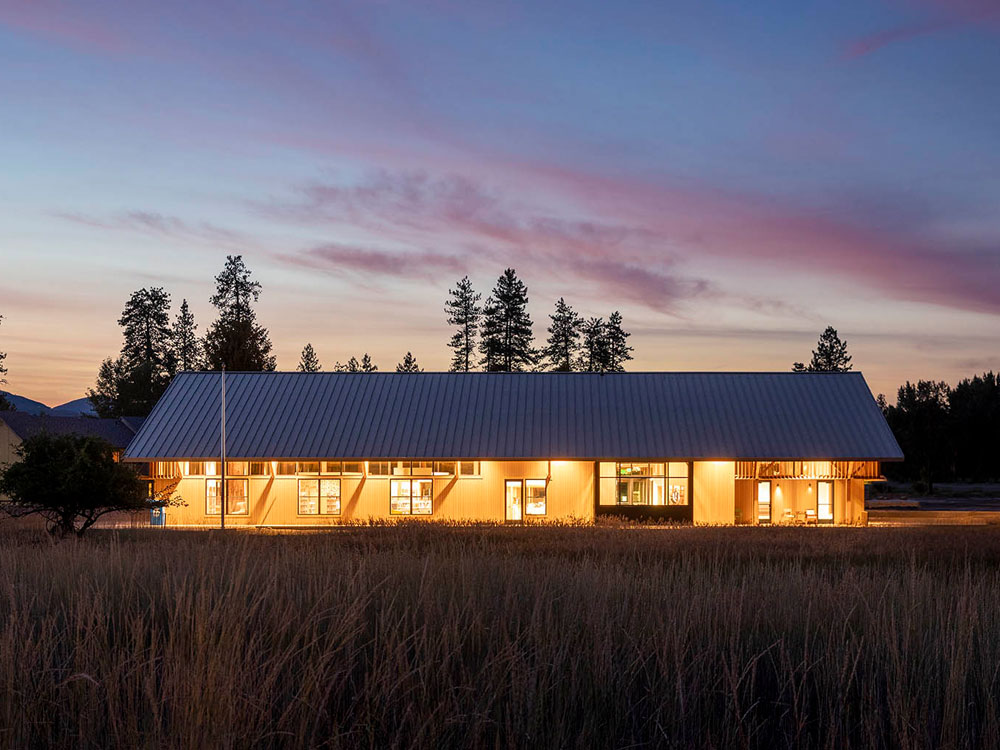
Core Design Team
Firm: Johnston Architects & Prentiss Balance Wickline Architects
Ray Johnston, FAIA
Partner-in-Charge, Johnston Architects
Margo Peterson-Aspholm, AIA
Prentiss Balance Wickline
Mary Johnston, FAIA
Partner-in-Charge, Johnston Architects
Tom Lenchek, AIA
Prentiss Balance Wickline
Mona Johnston Zellers, AIA
Johnston Architects
Harmony Cooper, AIA
Johnston Architects
Siyao Zhang, AIA
Johnston Architects
Elly Krutz
Johnston Architects
Consultants/Collaborators
ONWERSHIP
Owner: FRIENDS OF THE WINTHROP LIBRARY
Client: NORTH CENTRAL WASHINGTON LIBRARIES
DESIGN
Architect: JOHNSTON ARCHITECTS
Associate architect: PRENTISS BALANCE WICKLINE ARCHITECTS
Interior design: JOHNSTON ARCHITECTS
Landscape architect: KAREN KIEST LANDSCAPE ARCHITECTS
CONSULTANTS
Contractor: IMPEL CONSTRUCTION
Structural engineer: METHOW ENGINEERING
Civil engineer: METHOW ENGINEERING
Electrical engineer: AWA ELECTRICAL CONSULTANTS
Mechanical/plumbing engineer: SIDER + BYERS
PHOTOGRAPHY
Professional: BENJAMIN DRUMMOND
Supporting images: JA & PBW TEAM
Project Narrative
Of the place & for the people
This new library in Winthrop, Washington takes inspiration from the Methow Valley’s stunning natural environment. Its long axis points to Mount Gardner and its entrance faces the Methow River, reflecting the crossroads of mountain, river, and community.
The 1.8-acre site lies near the Susie Stephens Trailhead, offering year-round access to skiing, biking, and hiking. Adjacent to a preschool and an elder care facility serving local seniors, the library is also within walking distance of the town’s main street and easily accessible by school bus and public transportation. A nearby riverside park and interpretive center tell the story of the indigenous people of the Methow Valley, celebrating their relationship to the river. In this context, the Winthrop Library is part of a greater teaching and learning environment that extends far beyond its walls.
Agrarian inspiration
Working within the Town of Winthrop’s strict Westernization Architectural Code, requiring buildings to reference typical structures built 150 years ago, the design team looked to the dignified, utilitarian farm buildings of the surrounding landscape. Hay barns, with their wide, sheltering roofs and airy side walls, proved a perfect inspiration. A hay barn’s structural elements are exposed trusses and braces that provide the open, unobstructed volumes and access to light that are ideal for libraries. The hay barn’s scale is generous, providing for inspirational spaces that are lofty, warm, and familiar. The form is historic, authentic, and practical – all qualities that were desired in this new library’s exterior massing. The library was economical to construct using prefabricated openweb trusses, and while built during an unprecedented period of supply chain issues and escalation of labor and material costs, the 7,300 square foot library was built for just over $5 million. A combination of donations raised by Friends of the Winthrop Library, State of Washington funding, grants, and additional support from North Central Washington Libraries covered the project’s total cost of $8 million.
The public’s library
Through numerous public meetings and workshops, focus groups, surveys, and interviews, the design team learned the community wanted their new library to be as sustainable as possible while understanding budgetary restrictions. Providing opportunities to read, gather, learn, play, and find refuge, the library represents a building block of a resilient community and a more holistic definition of sustainability. The building shell is insulated and sealed to exceed code requirements, with distinctive exterior sunshades crafted from sustainably manufactured Kebony. The interiors make use of recycled, low-VOC materials and wood slats on ceilings and walls provide superb acoustical performance. Building systems include an advanced heating and air-conditioning split system in conjunction with an energy recovery ventilator. Outfitted with MERV filters, the
library is designed as a clean-air community refuge during the region’s frequent wildfire season. All plumbing fixtures are low-flow and light fixtures are LED, planned in conjunction with smart controls and extensive daylighting. The architectural team studied heat gain, energy usage, daylighting, and glare using technology developed in-house and designed the building to cut down on maintenance and operations expenses over time. The site is landscaped with native, drought tolerant plants, and the soon-to-be-completed Outdoor Library strengthens its educational mission and furthers the concept of region-specific, environmentally responsible landscaping.
Community connections
Flexible and adaptable, the library’s floor plan features one large, open space with high ceilings and extensive access to natural light. Library shelving is mobile and can be moved out of the center of the space – or removed altogether – if the community decides it wants to use the building for another purpose in the future. Installed throughout the library, specially curated art by local artists gives patrons another connection with the facility as part of their community story. Over-sized sliding doors introduce patrons to the library’s reading room and are laser cut with the names of 2,000 donors. The children’s restroom is hidden inside a fanciful treehouse inspired installation. A majestic, burned cedar snag is the focal point of the reading room, reminding patrons of the resilience of the community in the face of adversity. This artistry contributes to the library’s authentic sense of place.
The success of an integrated, iterative process between the client, design team, and public has led to long-term relationships between the architects, community leaders, Friends of Winthrop Library nonprofit group, various grantors and other donors, and the rural library district responsible for staffing and maintaining the facility. The Winthrop Library is widely recognized throughout the Methow Valley and the North-Central Washington region and has been cited as an example of what can be accomplished by a community when they work together toward a common goal.
The Winthrop Library has received rave reviews since its opening and brought out the poet in at least one patron. When asked what they loved most about the library, their answer was, “Books, books, wide windows, with long valley looks













